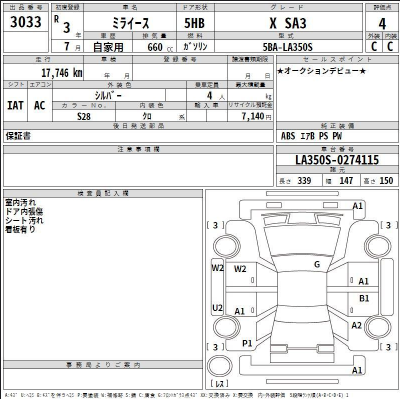Hello, future car experts! Have you ever seen a car that looks a little different in certain spots? Maybe the color doesn’t quite match, or the surface seems wavy? These might be repair marks!
In Japan, when inspectors check cars for auctions, they use special codes to describe these repair marks. W1 W2 W3 marks help explain how noticeable the repairs are. In this article, we’ll learn all about these codes in super simple words. Let’s become repair mark detectives!

What Are W1 W2 W3 Marks?
Repair marks are signs that a part of the car has been fixed or repainted. Think of them like bandages on a person’s skin—they show where something was healed.
Cars can have repair marks for many reasons:
- A scratch or dent was fixed
- The car was in a small accident and needed repair
- Part of the car was repainted to match the rest
Repair marks can be very hard to see or very obvious. The codes W1 W2 W3 marks tell the difference.
W1 Repair Mark: Negligible Repair Mark/Wave
W1 repair marks are very, very hard to notice. They are like a light breeze on water—almost invisible!
- What it looks like: If you look very closely, you might see a tiny difference in color or a very small wave in the paint. Most people won’t see it at all.
- What it means: The car had a very small repair, like a tiny scratch being fixed. It was done carefully.
- What to do: Nothing! W1 marks are not a problem. Many used cars have them.
Example: It’s like putting a small bandage on a tiny cut—it helps, but you can barely see it.
W2 Repair Mark: Repair Mark/Wave
W2 repair marks are easier to see. They are like a gentle wave on a pond—noticeable if you look.
- What it looks like: You might see a slight color difference or a small wave in the paint when light shines on it.
- What it means: The car had a repair that was done well, but not perfectly. It might have been a bigger scratch or a small dent.
- What to do: It’s usually okay. The repair is solid, but the look isn’t perfect.
Example: It’s like a larger bandage that you can see, but it doesn’t hurt anything.
W3 Repair Mark: Obvious Repair Mark/Wave
W3 repair marks are very easy to see. They are like big waves in the ocean—hard to miss!
- What it looks like: The color might not match well, or the surface might look wavy or uneven. You can see it without looking hard.
- What it means: The car had a big repair, like after a larger accident. The repair might not have been done very carefully.
- What to do: Be careful! W3 marks can mean the repair wasn’t done well. The car might have hidden problems.
Example: It’s like a big, bulky bandage that stands out and might make you wonder what happened.
Why Should You Care About Repair Marks?
Knowing about W1 W2 W3 repair marks helps you understand the car’s history and condition.
- Safety: Big repairs might mean the car was in an accident. There could be hidden issues.
- Value: Cars with W3 marks might be worth less because the repairs are obvious.
- Looks: If you want a car that looks nice, W2 or W3 marks might bother you.
How to Spot Repair Marks
You can look for repair marks yourself! Here’s how:
- Look at the Car in Daylight: Sunlight helps you see color differences and waves.
- Shine a Light on the Car: Move a flashlight along the surface. Waves or color changes will become clearer.
- Check from Different Angles: Walk around the car and look from the front, side, and back.
Remember—always ask for permission before touching or inspecting someone else’s car!
What to Do If You Find Repair Marks
- W1 Marks: No need to worry. They are tiny and don’t affect the car.
- W2 Marks: Think about whether the look bothers you. The car is still safe to drive.
- W3 Marks: Ask questions! Find out why the repair was done and if there are other hidden issues.
Fun Facts About Repair Marks
- 🚗 Repair marks are common on used cars—almost every car has at least a W1 mark!
- 🌞 Sunlight can make repair marks easier to see because it highlights color differences.
- 🔧 Good mechanics can make repairs almost invisible—like magic!
Let’s Review
- W1 Repair Marks: Very hard to see—like a secret!
- W2 Repair Marks: Noticeable if you look—like a hint!
- W3 Repair Marks: Easy to see—like a shout!
Now you understand W1 W2 W3 marks! The next time you see a car, you can look for these signs and guess what code it might have.
If you are buying a car, always check the auction sheet for these codes. If you need help understanding the sheet, services like JP Sheets can make it easy for you!
Happy car exploring!